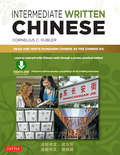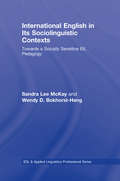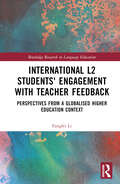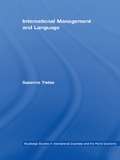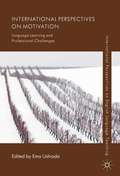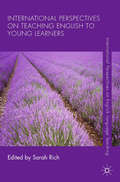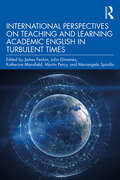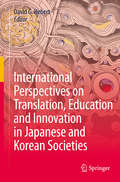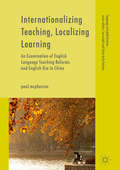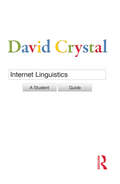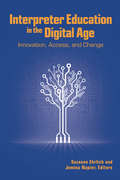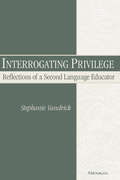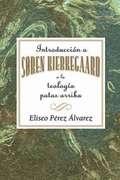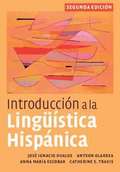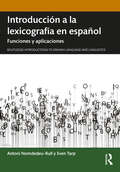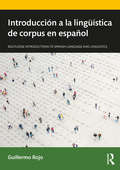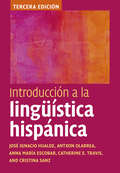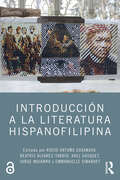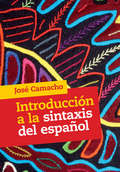- Table View
- List View
Intermediate Written Chinese
by Cornelius C. KublerThis is an intermediate-level course in written Chinese that employs a revolutionary new method designed to have you quickly reading and writing simple, connected Chinese sentences. The Basic Chinese and Intermediate Chinese books provide separate but integrated "tracks" to help you learn to read, write and speak Chinese efficiently at your own pace. Some students and teachers wish to emphasize speaking ability first, whereas others wish to focus on learning to read and write Chinese at the same time. Intermediate Written Chinese allows you the flexibility to learn the spoken language and the written Chinese at your own pace. Learn to use 288 high frequency characters, and over 700 common words written with them. Carefully designed to have you quickly reading and writing connected Chinese sentences. Both simplified and traditional characters are taught throughout; you may choose to learn one or both. Features a variety of fonts in both typeset and handwritten styles, to prepare you to use Chinese in many different contexts—from reading signs and newspapers, to computers and mobile phone texts. Hours of native-speaker recordings and practice sheets, plus printable flash cards on the enclosed CD-ROM. The accompanying CD-ROM includes: Over 6 hours of audio by several native Mandarin speakers. Recordings of all reading selection. Additional characters. New vocabulary. Available separately, Intermediate Written Chinese Practice Essentials is the companion workbook for Intermediate Written Chinese. This practical guide includes a broad range of drills and exercises designed to dramatically enhance your proficiency in reading and writing Chinese. While designed for use with the companion textbook, it can be used together with any Chinese textbook or teaching program to hone your Chinese reading and writing language skills.
International English in Its Sociolinguistic Contexts: Towards a Socially Sensitive EIL Pedagogy (ESL & Applied Linguistics Professional Series)
by Sandra Lee McKay Wendy D. Bokhorst-HengPresent-day globalization, migration, and the spread of English have resulted in a great diversity of social and educational contexts in which English learning is taking place. A basic assumption of this book is that because English is an international language, effective pedagogical decisions cannot be made without giving special attention to the many varied contexts in which English is taught and learned. Its unique value is the combination of three strands – globalization, sociolinguistics, and English as an international language – in one focused volume specifically designed for language teachers, providing explicit links between sociolinguistic concepts and language pedagogy. International English in Its Sociolinguistic Contexts: fully recognizes the relationship between social context and language teaching describes the social and sociolinguistic factors that affect the teaching and learning of English examines how the social context is influential in determining which languages are promoted in schools and society and how these languages are taught is unique in directly relating basic constructs in sociolinguistics to English language teaching features case studies that illustrate the diversity of English teaching contexts Directed to a wide TESOL and applied linguistics professional readership, this text will be particularly useful and effective for pre-service and in-service professional development in TESOL for K-12 and higher education levels.
International L2 Students' Engagement with Teacher Feedback: Perspectives from a Globalised Higher Education Context (Routledge Research in Language Education)
by Fangfei LiFangfei Li investigates L2 international students’ engagement with teacher feedback in the UK higher education system. She focuses on Chinese students studying at a UK university and explores their engagement with the feedback from local teachers and the factors which influence their participation and engagement.Offering numerous illustrative examples of how students transformed their understanding of feedback into revision practices, Li explores how the students’ feedback literacy is identified. The rich qualitative interview and textual data presented in this book highlight the situated and multifaceted nature of student feedback literacy. The data also demonstrate the necessity for local tutors to be fully aware of the challenges for international students in engaging with discipline-bounded feedback, and how to adjust instruction and feedback practice accordingly, to foster their students’ success in higher education.This book is essential for researchers and research students in education, applied linguistics, especially feedback fields, and English for academic purposes (EAP) educators and university lecturers who work with international students and use feedback as a teaching device.
International Management and Language (Routledge Studies in International Business and the World Economy #Vol. 41)
by Susanne TietzeGlobalization processes have resulted in the emergence of business and management networks in which the sharing of knowledge is of crucial importance. Combining two contemporary and important subject areas – namely that of international management and also language and communication in multi-language contexts – the author of this book presents a wealth of ideas, examples and applications taken from international and global contexts, which show that ‘language matters’ in the pursuit of international business affairs. The book establishes the theoretical core of its main ideas by introducing two orientations (social construction and linguistic relativity) and demonstrates how they can be drawn on to frame and understand the activities of managers. Highly innovative and topical, Susanne Tietze’s book will appeal to students of international management and international human resource management as well as those studying intercultural communication. It is also useful for managers and practitioners who work internationally.
International Perspectives On Materials In Elt
by Sue Garton Kathleen GravesThis book brings together different perspectives on ELT materials from a range of international contexts and a variety of educational settings. All the chapters are underpinned by sound theoretical principles while addressing practical concerns and debates in materials design and use.
International Perspectives on Motivation
by Ema UshiodaBringing together motivation-related practical concerns and debates from diverse international contexts and educational settings where English is learned, this book shows how locally produced insights and issues can have wider global significance, resonating with the experiences and concerns of English teachers and learners across the world.
International Perspectives on Teaching English to Young Learners
by Sarah RichThis volume comprises 11 research-led accounts from Teaching English to Young Learner (TEYL) educators working in a range of diverse settings worldwide. The innovative practical and theoretical perspectives offer some important insights into effective TEYL pedagogy for the 21st century.
International Perspectives on Teaching and Learning Academic English in Turbulent Times
by Katherine Mansfield James Fenton Julio Gimenez Mariangela Spinillo Martin PercyThis volume shares proven strategies for Academic English teaching, research, and development in challenging circumstances. Through original first-hand experiences from around the world, the collection reveals how educators in higher education have responded to the specific needs and challenges of teaching second language learners in turbulent times, as seen during the COVID-19 pandemic. Organised thematically, the book covers rapid responses to crises, adapting to teaching online, collaborations and online learning communities, and assessment practices. The volume provides original insights and practical suggestions for a range of practices across English for Academic and Specific Purposes that can address new and unfamiliar circumstances, both now and in future challenging times. The collection includes a wealth of effective strategies, varied research methodologies, and resources for practice making it an invaluable reference for practitioners, students, and researchers in the field of academic English, ESL/EFL, and online language instruction.
International Perspectives on Translation, Education and Innovation in Japanese and Korean Societies
by David G. HebertThis book studies the three concepts of translation, education and innovation from a Nordic and international perspective on Japanese and Korean societies. It presents findings from pioneering research into cultural translation, Japanese and Korean linguistics, urban development, traditional arts, and related fields. Across recent decades, Northern European scholars have shown increasing interest in East Asia. Even though they are situated on opposite sides of the Eurasia landmass, the Nordic nations have a great deal in common with Japan and Korea, including vibrant cultural traditions, strong educational systems, and productive social democratic economies. Taking a cross-cultural and interdisciplinary approach, and in addition to the examination of the three key concepts, the book explores several additional intersecting themes, including sustainability, nature, humour, aesthetics, cultural survival and social change, discourse and representation.This book offers a collection of original interdisciplinary research from the 25th anniversary conference of the Nordic Association for Japanese and Korean Studies (2013). Its 21 chapters are divided into five parts according to interdisciplinary themes: Translational Issues in Literature, Analyses of Korean and Japanese Languages, Language Education, Innovation and New Perspectives on Culture, and The Arts in Innovative Societies.
International Student Education in Tertiary Settings: Interrogating Programs and Processes in Diverse Contexts
by Zuocheng Zhang Trevor Grimshaw Xingsong ShiInternational Student Education in Tertiary Settings addresses key issues in international student education programme design and implementation. It maps contemporary theories and practices in international students’ transcultural learning and engagement and showcases successful tertiary education programmes for international students in Australia, China, Japan, the USA and the UK. The book highlights the opportunities for engaging international students that are built into the various programmes, international students’ strategies for coping with various challenges of engagement with their educational programmes, and a range of factors that confound their engagement in academic and intercultural learning. The broad coverage of international education programmes in a variety of geographical, sociocultural and pedagogical settings enables the discussion about the complexity of contemporary international student education, shared challenges and productive ways of engaging international students in transcultural learning and the prospect of sustainable engagement. The principles and insights into programme design and implementation to engage international students will be useful for researchers and practitioners in international student education, academics tasked with teaching international students in their class, and administrators responsible for managing and providing services to international students.
International: Towards a New Conceptualisation (Routledge Research in International and Comparative Education)
by Aneta Hayes Sihui WangThis book presents new narratives about international students undertaking transnational education (TNE) in East and Southeast Asia.With contributions from leading experts in international higher education, each chapter provides important critical arguments about the outdatedness of traditional labels that we tend to use when describing international students and their experiences. The book disrupts these narrow labels with voices and authors from Japan, Laos, China, and Vietnam to show that the categories through which we see international students overshadow the complexities of the students themselves and how their TNE experiences shape them. The book examines the traditional label of an ‘international student’ and invites readers to explore and use the alternative phrase ‘internationalised student.’This book will appeal to scholars, upper-level students, and researchers interested in international and comparative education, transnational education, migration studies, and higher education administration.
Internationalizing Teaching, Localizing Learning
by Paul McpherronBased on ethnographic and policy data collected over a ten-year span at a university in the People's Republic of China, this book analyses the history of English Language Teaching (ELT) polices in Chinese higher education. The book uses the university as a lens in which to investigate the creative imaginations and divergent (re)appropriations of teaching methods, learning materials, and language use in the Chinese ELT context. Book chapters move beyond mere descriptions of tensions and point to the local understandings and practices of English teachers (both local and foreign) and students. Working together, these teachers and students are constantly articulating new social and political conditions and meanings outside and inside given discourses and traditions of ELT. The book's main argument is that these multiple stakeholders must be given a more prominent role in shaping policy and curriculum at universities and other English language contexts around the world.
Internet Linguistics: A Student Guide
by David CrystalThe Internet is now an integral part of contemporary life, and linguists are increasingly studying its influence on language. In this student-friendly guidebook, leading language authority Professor David Crystal follows on from his landmark bestseller Language and the Internet and presents the area as a new field: Internet linguistics. In his engaging trademark style, Crystal addresses the online linguistic issues that affect us on a daily basis, incorporating real-life examples drawn from his own studies and personal involvement with Internet companies. He provides new linguistic analyses of Twitter, Internet security, and online advertising, explores the evolving multilingual character of the Internet, and offers illuminating observations about a wide range of online behaviour, from spam to exclamation marks. Including many activities and suggestions for further research, this is the essential introduction to a critical new field for students of all levels of English language, linguistics and new media.
Interpreter Education in the Digital Age: Innovation, Access, and Change
by Jemina Napier Suzanne EhrlichThis collection brings together innovative research and approaches for blended learning using digital technology in interpreter education for signed and spoken languages. Volume editors Suzanne Ehrlich and Jemina Napier call upon the expertise of 21 experts, including themselves, to report on the current technology used to provide digital enhancements to interpreter education in Australia, New Zealand, Brazil, Belgium, the United Kingdom, and the United States. Divided into three parts, Innovation, Change, and Community Engagement, this study focuses on the technology itself, rather than how technology enhances curriculum, delivery, or resources. Initiatives described in this collection range from the implementation of on-demand interpreting using iPad technology to create personalized, small-group, multidimensional models suited to digital media for 160 languages; introducing students to interpreting in a 3D world through an IVY virtual environment; applying gaming principles to interpreter education; assessing the amenability of the digital pen in the hybrid mode of interpreting; developing multimedia content for both open access and structured interpreter education environments; to preparing interpreting students for interactions in social media forums, and more. Interpreter Education in the Digital Age provides a context for the application of technologies in interpreter education from an international viewpoint across languages and modalities.
Interpreting Communicative Language Teaching: Contexts and Concerns in Teacher Education
by Sandra J. SavignonThe emergence of English as a global language, along with technological innovations and the growing need for learner autonomy, is changing language teaching rapidly and profoundly. With these changes come new demands and challenges for teaching education programs. This authoritative collection of writings highlights some of the best work being done today in the United States and abroad to make communicative competence an attainable goal. The contributors examine what has come to be known as communicative language teaching, or CLT, from the perspectives of teachers and teacher educators. The book documents current reform initiatives in Japan, the United States, Hong Kong, Taiwan, and continental Europe to provide a global perspective on language teaching for communicative competence. Four major themes recur throughout the volume: the multifaceted nature of language teaching; the highly contextualized nature of CLT; the futility of defining a "native speaker" in the postcolonial, postmodern world; and the,overwhelming influence of high-stakes tests on language teaching. The book is a useful and valuable tool for language teachers, teacher educators, and policymakers.
Interrogating Privilege: Reflections of a Second Language Educator
by Stephanie VandrickInterrogating Privilege is a welcome combination of personal essays and academic research, blending theory, analysis, and narrative to explore the function and consequences of privilege in second language education. While teachers’ focus on the learning process and class goals are quite important, there is not enough attention paid to the types of privilege—or lack thereof—that individuals bring to the classroom. Through chapters that can either stand alone or be read together, with topics such as gender, age, and colonialism (the author is the daughter of missionary parents) in second language teaching, this book seeks to address the experiences of teachers, scholars, and students as “whole persons” and to observe the workings of identity and privilege in the educational setting.
Introducción a Søren Kierkegaard, o la teología patas arriba AETH: Introduction to Soren Kierkegaard Upside Down Theology AETH (Spanish)
by Association for Hispanic Theological EducationEliseo Pérez Álvarez presenta en su libro a un Kierkegaard que va más allá de lo que leemos de él en muchas introducciones. Aquí, además, es el profeta, el denunciante de la injusticia social y de la hipocresía eclesiástica y religiosa. Eliseo "nos engancha entreteniéndonos con sus imágenes culinarias, al tiempo que nos lleva a reconocer cuanta razón tenía Kierkegaard en mucho de lo que dijo …"In this book, the author presents a Kierkegaard that goes beyond what we read of him in many textbooks. Aside from a look at Kierkegaard the prophet, the denouncer of the social injustice and of the religious and ecclesiastical hypocrisy, Álvarez treats readers to a detailed examination of the times that formed Kierkegaard’s teachings and philosphies.Eliseo Perez-Alvarez studied theology and philosophy in Mexico City, Atlanta, Chicago and Copenhagen. He has been professor, pastor, editor and coordinator for Hispanic Ministries in Mexico, USA, Puerto Rico and the Virgin Islands. He currently is an Associate Professor of Latino Theology and Mission at the Lutheran Seminary Program in the Southwest in Austin, Texas.
Introducción a la Lingüística Hispánica
by José Ignacio Hualde Antxon Olarrea Anna María Escobar Catherine E. TravisWritten in Spanish, this introduction to Spanish linguistics covers the structure, history and dialects of the Spanish language. It is designed primarily as a textbook for students pursuing advanced studies in Spanish language and literature at North American institutions, either at the advanced undergraduate or at the beginning graduate level. <p><p>Nevertheless, this book will also be useful to students in other instructional settings. Clear and accessible with exercises accompanying each chapter, the text will provide students with a solid foundation for pursuing further study in Spanish or general linguistics. <P><P><i>Advisory: Bookshare has learned that this book offers only partial accessibility. We have kept it in the collection because it is useful for some of our members. Benetech is actively working on projects to improve accessibility issues such as these.</i>
Introducción a la historia de la iglesia AETH: Introduction to the History of the Church Spanish
by Justo L. GonzalezIntroducción a la historia de la iglesia es una obra formidable en la que de manera amena, entretenida y sin dejar de ser académica, el Dr. Justo González repasa los acontecimientos fundamentales que sucedieron en la historia de la iglesia y que le han dado cuerpo. Este libro es fundamental como introducción para entender el porqué la iglesia tiene la forma que tiene en la actualidad, y servirá de base para cualquiera que desee adentrarse en los detalles de tan extensa y a veces complicada historia. Written in Spanish by the renown Hispanic author Justo L. González, this easy-to-understand and entertaining, yet academic introduction to the history of the church reviews the major events that happened in the history of the church and how they shape today’s church. This book is ideal for helping readers understand today’s church structure, and serves as guide for those interested in the extensive, and at times, complicated history of the church.
Introducción a la lexicografía en español: Funciones y aplicaciones (Routledge Introductions to Spanish Language and Linguistics)
by Antoni Nomdedeu-Rull Sven TarpIntroducción a la lexicografía en español. Funciones y aplicaciones ofrece una descripción innovativa de la historia lexicográfica en español, una crítica constructiva de los diccionarios existentes y una visión transformativa y optimista de la disciplina relacionada con las nuevas tecnologías. Basado en la teoría funcional de la lexicografía con un enfoque centrado en el usuario y sus necesidades de información, el libro contribuirá, sin duda, al "renacimiento" de la lexicografía en español. Su punto de partida es la detección de esas necesidades, la generación de datos que ayuden a resolverlas y la presentación de esos datos a los usuarios mediante un diseño de uso intuitivo.Características principales: Establecimiento de conceptos fundamentales de la lexicografía; Exposición de las tendencias principales en la lexicografía en español; Explicación de las fases para realizar un proyecto lexicográfico; Discusión de los métodos y técnicas de compilación más recientes; Propuestas de soluciones a problemas viejos y nuevos. Con su enfoque tanto descriptivo como transformativo, este libro es un recurso indispensable para cualquier investigador, profesor o estudiante de grado y posgrado que busque conocimientos más profundos de los diccionarios y productos similares en español.
Introducción a la lingüística de corpus en español
by Guillermo RojoIntroducción a la lingüística de corpus en español es la primera obra concebida desde la óptica del español para investigar los corpus textuales existentes en la actualidad. Destinada a conjugar armónicamente la exposición de cuestiones teóricas y metodológicas, proporciona información detallada sobre las tareas necesarias en el diseño, construcción y explotación de un corpus a partir de numerosos ejemplos de obtención de datos sobre diferentes cuestiones léxicas y gramaticales. Características principales: • Exposición de cuestiones teóricas y metodológicas combinada con el tratamiento de casos prácticos de extracción y análisis de datos procedentes de corpus textuales de español; • Análisis de fenómenos léxicos y gramaticales del español desde diferentes perspectivas y con atención a la variabilidad diacrónica, diatópica y diastrática; • Indicación detallada del modo de obtener los datos necesarios para la investigación en diferentes corpus del español; • Inclusión de un resumen inicial, actividades de investigación en cada capítulo y lecturas complementarias recomendadas; • Presentación de un capítulo final con herramientas informáticas útiles para el análisis de textos no incluidos en corpus textuales; • Recopilación de los principales términos usados en la lingüística de corpus en un glosario bilingüe (español e inglés). Introducción a la lingüística de corpus en español es una obra con un enfoque marcadamente didáctico, y dirigida fundamentalmente a estudiantes avanzados de grado y posgrado, profesores que necesiten hacer uso de corpus en sus clases, investigadores que precisen un conocimiento más profundo de la lingüística de corpus o expertos en otras disciplinas que deseen familiarizarse con una perspectiva técnica de los fenómenos lingüísticos.
Introducción a la lingüística hispánica
by José Ignacio Hualde Antxon Olarrea Anna María Escobar Catherine E. Travis Cristina SanzWritten entirely in Spanish, this is the ideal introduction to Spanish linguistics for students. Using clear explanations, it covers all the basic concepts required to study the structural aspects of the Spanish language – phonetics and phonology, morphology, syntax and semantics – as well as the history of Spanish, its dialects, and its linguistic variation in Latin America, Spain, and the US. This third edition incorporates new features designed to enhance its usefulness for classroom teaching: a new chapter on the teaching and learning of Spanish as a second language, expanded discussion of syntax, and more detailed coverage of Spanish semantics and pragmatics. Numerous exercises have been added throughout the text, some of which are now presented as problems for students to solve, allowing students to gain a more complete mastery of the analytical concepts at hand.
Introducción a la literatura hispanofilipina
by Axel Gasquet Rocío Ortuño Casanova Beatriz Álvarez-Tardío Jorge Mojarro Emmanuelle SinardetIntroduccion a la literatura hispanofilipina ofrece una panorámica sobre la literatura en español producida en Filipinas.Introduccion a la literatura hispanofilipina, primer libro de este tipo escrito en el siglo XXI, reúne en un solo volumen el conocimiento de múltiples académicos expertos en la literatura filipina en español. El libro, que está ordenado cronológicamente, aborda los debates actuales y ofrece un amplio panorama del corpus literario filipino, que presenta con pericia, sirviendo de introducción al campo tanto para estudiantes como para profesores. Los capítulos abarcan un amplio abanico de movimientos literarios y periodos temporales, desde la expedición Magallanes-Elcano hasta nuestros días, y a menudo representan el primer estudio jamás realizado sobre los textos que abordan.Este volumen es esencial para estudiantes, profesores e investigadores de literatura en lengua española, estudios hispánicos y estudios asiáticos. También será un recurso inestimable para quienes busquen incorporar elementos, temas o autores filipinos en sus clases o investigaciones.The Open Access version of this book, available at www.taylorfrancis.com, has been made available under a Creative Commons Attribution-Non Commercial-No Derivatives (CC-BY-NC-ND) 4.0 license._________________________________________________________________________________________________Introducción a la literatura hispanofilipina offers a panoramic introduction to Spanish-language literature produced in the Philippines.The first book of its kind written in the 21st century, Introducción a la literatura hispanofilipina brings together a wealth of knowledge from scholars of Philippine literature in Spanish in one comprehensive volume. Ordered chronologically, the book engages with current debates and provides a thorough survey of the Philippine corpus of literature that expertly introduces the topic to students and professors alike. Covering a variety of literary movements and time periods, from the Magellan-Elcano expedition right up to the present day, many chapters represent the first ever survey of their subject.This volume is essential for students, professors, and researchers of Literature(s) in the Spanish language, Hispanic studies, and Asian studies. It will also be an invaluable resource for those looking to incorporate Filipino elements, themes, or authors into their classes or research.The Open Access version of this book, available at www.taylorfrancis.com, has been made available under a Creative Commons Attribution-Non Commercial-No Derivatives (CC-BY-NC-ND) 4.0 license.
Introducción a la sintaxis del español
by José CamachoEscrito en español por un instructor con gran experiencia, este libro de texto les ofrece a estudiantes sin conocimientos previos de lingüística una introducción a la sintaxis del español, explorando los elementos esenciales que forman las expresiones lingüísticas complejas. El texto resalta la diversidad de los dialectos del español y de las variedades habladas por bilingües. Los conceptos nuevos se presentan de manera clara y progresiva, desde lo más simple a lo más complejo, resaltando las deinciones de los términos clave en recuadros independientes. Los desarrollos teóricos más recientes se ofrecen con una perspectiva equilibrada, sin énfasis especial en un modelo teórico especíico. Cada capítulo presenta objetivos de aprendizaje, numerosos ejemplos detallados y resúmenes que le permiten al estudiante desarrollar su comprensión del conocimiento sintáctico desde cero. Se incluyen ejercicios introductorios y avanzados en cada capítulo, lo que les permite a los estudiantes de todos los niveles poner en práctica los conocimientos. Las lecturas adicionales sugeridas en los capítulos y los desarrollos más avanzados presentados en recuadros de expansión le ofrecen al estudiante la posibilidad de explorar temas más complejos. Este texto constituye un recurso esencial para los cursos introductorios de lingüística y de sintaxis española.
Introducción a la sintaxis del español (Routledge Introductions to Spanish Language and Linguistics)
by Guillermo Rojo Belén López Meirama María José Rodríguez Espiñeira Victoria Vázquez RozasLa Introducción a la sintaxis del español proporciona una panorámica general de la sintaxis del español. El libro analiza el uso y la variación interna para presentar las estructuras sintácticas en el marco de una consideración funcionalista de la lengua como un sistema dinámico y variable.La obra aborda conceptos generales de sintaxis, la estructura de la cláusula, fenómenos clausales de particular importancia, la combinación de cláusulas y las características básicas de las frases. Cada uno de los dieciocho capítulos desarrolla un tema concreto, incluye ejemplos y ejercicios destinados a consolidar el conocimiento de los estudiantes y sugiere lecturas que permiten profundizar en las cuestiones tratadas. Los elementos y fenómenos analizados son ilustrados con ejemplos procedentes de diferentes variedades del español contemporáneo extraídos de corpus escritos y orales. El libro combina la visión general de los principios de la aproximación funcionalista con el análisis de los aspectos que presentan mayor interés y resultan de mayor utilidad didáctica en los niveles introductorios.Dirigida a estudiantes de lengua española y lingüística, la Introducción a la sintaxis del español constituye una introducción innovadora y accesible a la sintaxis española para estudiantes de español como lengua extranjera y hablantes nativos.El libro tiene una página de apoyo con las soluciones a los ejercicios de cada capítulo en www.routledge.com /9781032438467.------------------------------------------------------------------------------------------------------------------------------------------------------Introducción a la sintaxis del español provides a panoramic introduction to the study of Spanish syntax. Taking a functionalist approach, the book considers usage and language-internal variation to present syntactic structure within the context of language as an inherently dynamic and variable system.The book addresses general concepts of syntax, the structure of the clause, clause phenomena of particular importance, the combination of clauses and the basic characteristics of phrases. Each of the eighteen chapters develops a specific topic and provides a wealth of examples and exercises to cement students’ knowledge as well as offering guidance for further reading. The elements and phenomena analysed are illustrated with examples from all the current varieties of Spanish, taken from corpora and the spoken language. The book combines a comprehensive overview of the general principles of a functionalist approach to language with an analysis of the syntactic aspects that are the most interesting and didactically useful at the introductory level.Aimed at students of Spanish language and linguistics, Introducción a la sintaxis del español offers an innovative and user-friendly introduction to the topic of Spanish syntax for students of Spanish as a foreign language and native speakers.The author’s website for the book which includes further exercises and answer keys is accessible via www.routledge.com/9781032438467.
